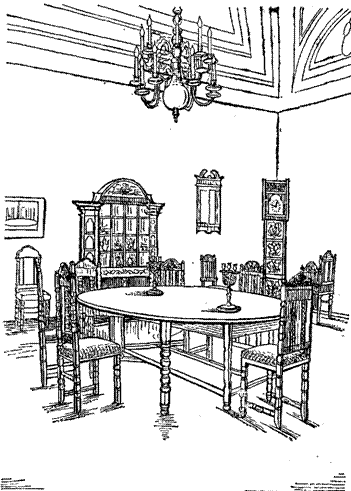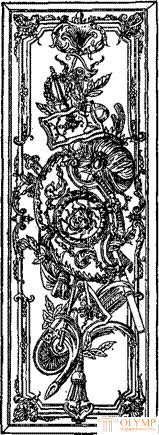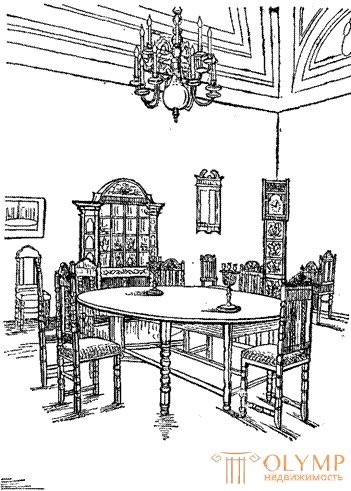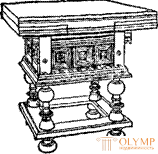
Late XVII - early XVIII century they were a turning point in the history of Russia: the age-old backwardness was overcome, the state was strengthened, industry developed, the regular army and navy were organized. The history of Russia of this period is inextricably linked with the personality of Peter I - the largest political figure of that era, the reformer of the country. In 1703, Peter created a new capital, St. Petersburg, where he concentrated construction and architectural activity.
At the end of XVII - especially at the beginning of the XVIII century. Art becomes predominantly secular, which is manifested in a change in the nature of the architecture that addresses European forms. Petersburg is being built up with wooden buildings imitating stone and brick, which led to the development of wooden sculpture. Peter I transfers all Moscow carvers to Petersburg, where he organizes special workshops.
In 1725, the Academy of Sciences was founded in St. Petersburg with a gymnasium. Capable young people are sent abroad to master various sciences, arts and crafts. For training carpentry sent to England and Holland. At the beginning of the XVIII century. created the first special art schools.
Preparing his own craftsmen, Peter I also calls for foreign scientists and specialists to work in Russia, including carpenters, furniture upholsterers, carvers, wood turners, cartwrights and gilders.
At the beginning of the XVIII century. In St. Petersburg, such structures as the Peter and Paul Fortress (1712-1713, D. Trezzini), the Summer Palace of Peter I (started in 1711 by D. Trezzini, ended in 1714 by A. Schlüter) were created; the palace and park ensemble at Peterhof, the palaces of Monplaisir, Marly, the Hermitage (I. Braunstein, A. Leblon, N. Michet-ti, P. M. Eropkin, M. G. Zemtsov and T. Usov); the building of the twelve colleges (1722-1733, D. Trezzini); the first building of the Admiralty (1732-1738, IK Korsbov); The Kunstkamera (1718-1734, G.I. Mattarnovi, M.T. Zemtsov). They were strict and simple in form. Even in the palace premises, the interiors were simple and modest.
The walls of the rooms and halls were decorated with wooden carved panels. Mirrors, silver chandeliers, tiled stoves and paintings, mostly depicting seascapes, appeared in the interiors. The floor was made of ceramic tiles or parquet. Furniture - cabinets, display cases, oak chairs and armchairs, upholstered in leather, with carvings and chiseled details - were arranged along the walls.
A typical example of the interior design of this period is the cabinet of Peter I with oak panels in the Grand Peterhof Palace, which was finished according to the design of architect A. Leblond, and carvings that constitute the main advantage of the cabinet were made by Nikolay Pino who arrived at the invitation of Peter I from France (Fig. one).
In the decoration of the interior of the early XVIII century. a large place was occupied by wood, from which wall panels, door and window slopes, cornices, door leafs were made. Carved panels of oak, walnut and plane tree wood are introduced into the interior. Often panels tint or complement the painting. The wooden elements of the interior and furniture were tinted with further waxing, carving, sometimes with tinting.
The interiors of the palaces of the early XVIII century. furnished with furniture of Russian work (Fig. 2) and imported. During this period, the influence of baroque forms of furniture, especially in the Dutch and English versions, is decisive in Russian furniture. However, for Russian furniture, several squat forms with sculptural processing of load-bearing parts continue to be characteristic (Fig. 3).
The main types of artistic furniture decoration were carving and turned parts. At the end of the first quarter of the XVIII century. on furniture products inserts made of inlaid wood appeared. Sometimes the furniture was decorated with oil paintings (a table in the Hermitage, a cellar in the Armory), which later received a wide development.

Fig. 1. The carved panel of the cabinet of Peter I (Grand Palace in Peterhof. Author N. Pino, 1720)

Fig. 2. Russian furniture. Early XVIII

Fig. 3. Table. Early XVIII century.
For the manufacture of furniture mainly used oak. The surface of the product was tinted in a dark color and trimmed with wax. In the palaces used furniture made of walnut and mahogany, in the decoration of furniture painting - birch. The furniture was upholstered with smooth and embossed leather, colored velvet and cloth. Upholstery is usually fastened with nails with caps located close to each other.
One of the peculiarities of the furniture of the Peter epoch was that it was selected for the equipment of a room from individual objects, similar in form, wood and decoration. Chairs and chairs of various shapes, however, as a rule, had a back of considerable height, deaf or with a through board. The seat binding is wide, the legs are chiseled or curved, called cabrioles, in the upper part of the tsarga the leg greatly expanded, at the bottom it formed a bird's paw holding a ball. There were legs straight, smooth tetrahedral section. The armrests had a curved shape. Made of stools with a soft seat.
The most characteristic example of Peter's furniture is the Admiralty chair of Peter I, located in the Summer Palace.
Tables vary in size and purpose. The covers are rectangular or square, the underframe is massive with carved decorations, often with a drawer. The fine-shaped legs were fastened with a broad guide.
To increase the area of the table cover sometimes made sliding.
The most popular cabinets for the dress are double-wing rectilinear form with a massive cornice; large Danzig with a cartouche, cut into the eaves, with spherical legs, pilasters and paneled shutters with a solid carved large relief; The cabinets are small in size with a deaf, slightly protruding bottom and an upper glazed part. The mirrors were framed with a shaped or carved frame, the upper part of the frame was usually decorated with a complex ornament. Separate forms of furniture beginning of the XVIII century. (for example, high-backed chairs, mirror frames) have existed for a long time,
Что бы оставить комментарий войдите
Комментарии (0)